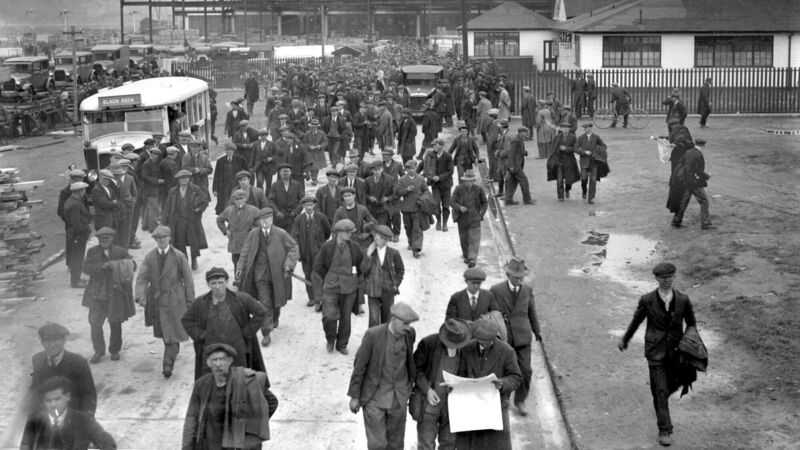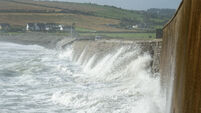Michael Moynihan: The conveyor belt of history offers fascinating insights of Leeside life

Shift workers leaving the Ford Factory at Cork’s Marina in 1929.
Every couple of years there seems to be another attack on history.
History in schools, I mean. This is unfortunate, because not knowing one’s history leads to unpleasant levels of ignorance. Events in certain countries on either side of us show what that ignorance can lead to, or sink to.
Not that all of the history we learned ourselves in school was helpful. Going back to the late Neolithic period, when I was doing history in school, the subject meant Tomás an tSioda and hilarious accounts of Daniel O’Connell’s by-election victories (“Glory Dan!” was the hashtag of the day).
Looking back, should we have learned more local history, the events which shaped our daily lives as we slogged to and from school and not just kings and battles?
There’s a place for the grand sweep of seminal, earth-shattering events when it comes to history — it seems sometimes there’s no better subject for the grand sweeping statement, anyway — but recent decades have brought home the importance of ordinary people’s lived experience when it comes to history.
Daniel O’Connell, mentioned above, is supposed to have said to one of his supporters, a labourer at the side of the road, that it hardly mattered who won elections or what legislation was passed, as the man would still be breaking rocks by the roadside.
Now we appreciate more than ever, though, the importance of learning about the life of that man working on the side of the road, and what his daily experience in the 19th century tells us — about him, and about us.
All of which is a long-winded way of getting to the matter at hand today, a book which caught my eye before Christmas.
by Liam Cullinane is precisely the kind of publication which triggers the pleasure centres in the middle of my brain.
What’s interesting to me, along with the book itself, is the process of creating it in the first place. For instance, it may sound obvious but it’s impossible to write a history if you don’t have records to draw on.
In the particular corner of Cork City where I grew up in, there was no shortage of people who worked in Ford and Sunbeam, but given (as mentioned) that was in the Middle Stone Age, not all of those people are still available for interview.
Accordingly, Cullinane had to see if there were such records available for the companies he wanted to study.
“Sunbeam kept pretty good records which are available in the Cork City and County Archives, and a lot of the Irish Steel records are in the National Archives because it was a state-owned enterprise," he says.
“Ford was a mixed bag in that I got a lot of stuff from the early years from the Benson Ford Research Centre in Dearborn, Michigan, and the rest I brought together from various sources, face to face interviews with former workers and so on.”
This was a first takeaway, but a significant one.
Those records — personnel files, memos, dockets — are as historical as any royal charters or treaties.
The history of people at work might not sound as dramatic as tales of battles and kings, but we all spend more time at work than at battle. By taking one step back, Cullinane was also able to put those Cork businesses in a national context. He points to an interesting mix — a privately owned domestic factory (Sunbeam), a state-owned factory (Irish Steel), and a multinational (Ford) — but also adds that “they were all industries which wouldn’t have been significant without protectionism.
“Sunbeam wouldn’t have expanded to any significant degree if it hadn’t been for government quotas and protections doled out by Sean Lemass and others.
“Ford had a different approach to workplace relations and of course brought in a certain ideology from America — it was more resistant to trade unions until it was eventually unionised — but it too was reliant on state aid, because there was protectionism helping Ford until tariffs were lifted from cars in the eighties, which spelt the end of the factory.
“Irish Steel had a number of protections as well, such as a scrap monopoly.
“But when those protections ended, the writing was on the wall for all three.”
None of the three survives today, of course. Which means there’s a legacy to grapple with. How do people remember Ford, Sunbeam, and Irish Steel?
“Sports and social clubs were strong in the three companies, and those helped form strong relationships among people which lasted for years after they closed.
“In general the companies are remembered differently, which is interesting in itself. People generally remember Ford and Sunbeam more fondly than Irish Steel, in part perhaps because the latter was a more dangerous workplace.
“I came across a horrific record of injuries and deaths in the (Irish Steel) plant, and the end was difficult — there was a period when it was owned by Ispat, there were redundancy disputes, and Cobh, which was the main feeder for Irish Steel, didn’t recover in industrial terms the way Cork City did after Sunbeam and Ford.”
As befits a PhD in history, Cullinane is a strong advocate for his subject.
“I think it’s important to give people a good mix of history — social history, political history, industrial history and so on.
“It might not apply in schools as much, but there’s huge work done in communities all over the country — in local history societies or by dedicated amateurs, for want of a better term. Take someone like Michael Lenihan here in Cork, his books are massive and ignite huge interest in this area.
“You don’t need a PhD in history or a university degree to be a historian, you can go into the archives and do the work. That’s the joy of this, it’s open to everyone regardless of qualifications.”
There’s surely a joy to making a discovery which articulates a vague notion in plain terms, particularly when that happens far from the battlefield or parliamentary chamber.
Take the point in Cork when one of the companies mentioned above began operations right at the intersection of the pre-industrial and industrial ages.
“There was something about Ford, in particular, in the early years that was quite surprising to me,” says Cullinane.
“For a while, it was the largest Ford facility outside the United States, and some of the correspondence in the twenties between Cork and Dearborn (company headquarters) is fascinating.
“What you had in reality were industrial managers from the United States coming up against a workforce which was mostly made up of former agricultural labourers and craftsmen.
“It was fascinating to see that perspective up close, because as a historian, while you’re interested in the managers’ perspective, you’re also trying to read ‘against’ those documents to try to get an insight into what the workers were thinking.”
How’s that for the sweep of history? People whose parents remembered the Famine grappling with hyper-modern industrial methodology: the conveyor belt.
And all of it happening down the Marina.











